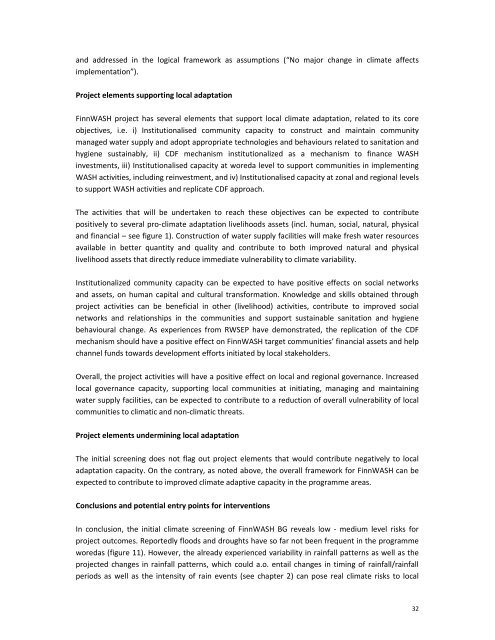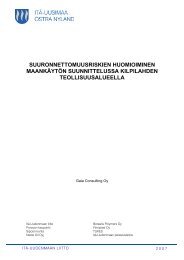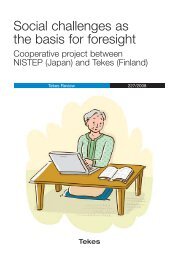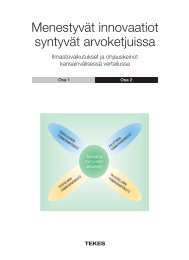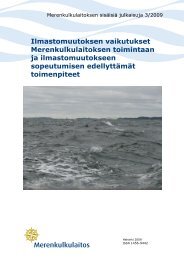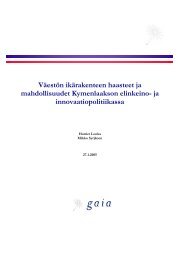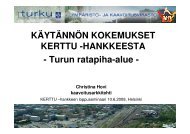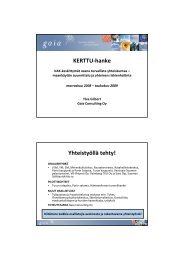Climate Risk Management in Finnish Development Cooperation - Gaia
Climate Risk Management in Finnish Development Cooperation - Gaia
Climate Risk Management in Finnish Development Cooperation - Gaia
Create successful ePaper yourself
Turn your PDF publications into a flip-book with our unique Google optimized e-Paper software.
and addressed <strong>in</strong> the logical framework as assumptions (“No major change <strong>in</strong> climate affects<br />
implementation”).<br />
Project elements support<strong>in</strong>g local adaptation<br />
F<strong>in</strong>nWASH project has several elements that support local climate adaptation, related to its core<br />
objectives, i.e. i) Institutionalised community capacity to construct and ma<strong>in</strong>ta<strong>in</strong> community<br />
managed water supply and adopt appropriate technologies and behaviours related to sanitation and<br />
hygiene susta<strong>in</strong>ably, ii) CDF mechanism <strong>in</strong>stitutionalized as a mechanism to f<strong>in</strong>ance WASH<br />
<strong>in</strong>vestments, iii) Institutionalised capacity at woreda level to support communities <strong>in</strong> implement<strong>in</strong>g<br />
WASH activities, <strong>in</strong>clud<strong>in</strong>g re<strong>in</strong>vestment, and iv) Institutionalised capacity at zonal and regional levels<br />
to support WASH activities and replicate CDF approach.<br />
The activities that will be undertaken to reach these objectives can be expected to contribute<br />
positively to several pro-climate adaptation livelihoods assets (<strong>in</strong>cl. human, social, natural, physical<br />
and f<strong>in</strong>ancial – see figure 1). Construction of water supply facilities will make fresh water resources<br />
available <strong>in</strong> better quantity and quality and contribute to both improved natural and physical<br />
livelihood assets that directly reduce immediate vulnerability to climate variability.<br />
Institutionalized community capacity can be expected to have positive effects on social networks<br />
and assets, on human capital and cultural transformation. Knowledge and skills obta<strong>in</strong>ed through<br />
project activities can be beneficial <strong>in</strong> other (livelihood) activities, contribute to improved social<br />
networks and relationships <strong>in</strong> the communities and support susta<strong>in</strong>able sanitation and hygiene<br />
behavioural change. As experiences from RWSEP have demonstrated, the replication of the CDF<br />
mechanism should have a positive effect on F<strong>in</strong>nWASH target communities’ f<strong>in</strong>ancial assets and help<br />
channel funds towards development efforts <strong>in</strong>itiated by local stakeholders.<br />
Overall, the project activities will have a positive effect on local and regional governance. Increased<br />
local governance capacity, support<strong>in</strong>g local communities at <strong>in</strong>itiat<strong>in</strong>g, manag<strong>in</strong>g and ma<strong>in</strong>ta<strong>in</strong><strong>in</strong>g<br />
water supply facilities, can be expected to contribute to a reduction of overall vulnerability of local<br />
communities to climatic and non-climatic threats.<br />
Project elements underm<strong>in</strong><strong>in</strong>g local adaptation<br />
The <strong>in</strong>itial screen<strong>in</strong>g does not flag out project elements that would contribute negatively to local<br />
adaptation capacity. On the contrary, as noted above, the overall framework for F<strong>in</strong>nWASH can be<br />
expected to contribute to improved climate adaptive capacity <strong>in</strong> the programme areas.<br />
Conclusions and potential entry po<strong>in</strong>ts for <strong>in</strong>terventions<br />
In conclusion, the <strong>in</strong>itial climate screen<strong>in</strong>g of F<strong>in</strong>nWASH BG reveals low - medium level risks for<br />
project outcomes. Reportedly floods and droughts have so far not been frequent <strong>in</strong> the programme<br />
woredas (figure 11). However, the already experienced variability <strong>in</strong> ra<strong>in</strong>fall patterns as well as the<br />
projected changes <strong>in</strong> ra<strong>in</strong>fall patterns, which could a.o. entail changes <strong>in</strong> tim<strong>in</strong>g of ra<strong>in</strong>fall/ra<strong>in</strong>fall<br />
periods as well as the <strong>in</strong>tensity of ra<strong>in</strong> events (see chapter 2) can pose real climate risks to local<br />
32


